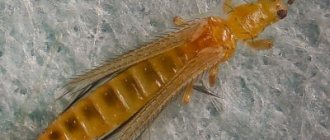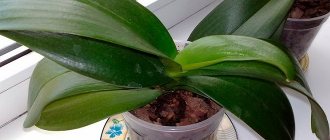Gladioli thrips: what they look like, photo and description
Thrips are tiny insects with fringed wings. The photo shows that the body of the pest is dark brown and reaches 1.5 mm in length. The insect reproduces by larvae. At the initial stage of development, the larva has a transparent white tint, gradually turning into light yellow. It takes 15-20 days for the larva to develop into an adult insect.
Both larvae and mature individuals are dangerous for the crop. One female is capable of laying up to 20-30 eggs. 8-9 generations develop during the season. The pest sucks juice from the stem, foliage and inflorescences of the plant, and is a carrier of various diseases, which harms all plantings on the site.
Pests attack crops regardless of the season. The first signs of damage are white spots on the foliage, then they dry out completely. During the flowering period, the pest of gladioli creeps into the middle of the bud and sucks out its nutritious juice. Due to such proximity, the inflorescence becomes discolored, and small holes are formed along the contour, which clearly appear after the bud is moistened. With a large lesion, the flower may not bloom.
thrips on gladioli photo
After the air temperature drops to 10 degrees Celsius, the parasite moves to the stem, and then to the tuber under the scales of the bulbous tuber. If you do not get rid of colonies in a timely manner, when stored in winter, the insect draws out all the juices from the planting material, which leads to complete drying out. Red-colored plaques covered with a dry crust form on the tubers.
The pest is omnivorous and can attack vegetable crops, garden and indoor flowers. There are several types of insects:
- Ornamental – affects mainly ornamental plants. It is rare when cultivated in a greenhouse.
- The black-haired one is a fairly small pest. The wings are underdeveloped or absent altogether. The length of an adult individual can reach 0.8-1.0 mm.
- Tobacco onion is dangerous for flower crops grown in unprotected soil. Often settles in crop bulbs. It takes 3-5 days after the eggs are laid for the larva to appear.
- The Western California flower is the most dangerous species. It sucks out all the nutritious juices from the crop. In hot, windless weather, the likelihood of crop damage increases. Settles on more than 250 varieties of crops.
- Pea - most often settles on peas, legumes, and can affect the tops of sprouts.
Who are thrips and why are they dangerous for gladioli?
Thrips are quite serious pests that parasitize almost all plants. More than 200 species of insects are found in the Russian climate. For gladiolus, the main threat is represented by Bulbous (Liothrips vaneeckei) and Herbivorous (Frankliniella intonsa) thrips; the pest is adapted to temperate climates and reproduces fully in greenhouses and in open areas.
Damage to gladiolus is caused by adults and larvae. Their size is so small that it is quite difficult to identify the problem visually. At the site of the main accumulation, light spots first appear, then the lesions darken and begin to dry out.
During budding, pests penetrate inside, the bud becomes discolored, and if there is a significant accumulation of insects, it stops developing and may not open. If a flower is formed, it is smaller in size; the edges of the petals are light in color with numerous holes. For bulbs, the presence of a parasite is extremely dangerous. The pest is located under the scales and cannot be identified. During storage of the bulbs, insects feed on their juice and by spring they look mummified.
Important! Spoiled planting material cannot be used for propagation due to the threat of infection of other crops.
The insect creates a large colony, localized mainly on the lower part of the leaf blades of a flowering crop.
In order for the fight against thrips (pictured) on gladioli to be effective, it is necessary to know its life cycle.
External characteristics:
- The body is elongated (up to 3 mm), dark gray or brown, depending on the species.
- The insect has two pairs of narrow, fringed wings.
- The mouthparts are piercing-sucking.
- A bubble-like device on six legs that sticks to the surface.
In the spring, when the air temperature warms up to +5–6 C, the female begins to lay eggs, up to 20 eggs. Development to an adult occurs in approximately 2 weeks; up to 15 generations are possible per season. The life cycle of an insect is 30–45 days. Development goes through the following stages:
- Egg. The most vulnerable stage, the masonry dries out and dies in hot weather, so it is not recommended to water the gladiolus completely; water can only be poured at the root. At the same time, even contact poisons do not affect the egg.
- Larva. After emergence, it begins to feed intensively, on the fourth day it reaches the size of an adult insect, goes into the top layer of soil, so loosening is important for gladioli, it destroys the environment necessary for the transformation of the larvae.
- The soil undergoes a stage of molting and degeneration into a pronymph; at a temperature above +25 C, the larva needs 24 hours for this process; if the temperature is below +18 C, it will take 4 days.
- The next stage is the nymph, after 3 days the adult.
Read more Planting gladioli in open ground in spring in the Moscow region
The adult comes to the surface after 24 hours and lays eggs.
Important! For sexual fertilization, the spring flight of the first females is sufficient. The rest of the reproduction is parthenogenetic, the females of subsequent generations are already fertilized, they do not need males.
In autumn, thrips descend to the lower part of the plant, the adults of the last generation go into the soil and overwinter in the bulbs. Therefore, it is quite difficult to completely destroy a parasitic insect. At the beginning of the season, thrips resume reproduction; it not only mechanically damages gladioli, but also spreads viral diseases.
Thrips on gladioli, how to deal with it, control measures
Gladiolus thrips is the main enemy of culture. If for some reason the flower is affected by a pest, it is necessary to immediately begin treatment. After all, the insect not only feeds on the vital juices of the plant, but is also a carrier of various diseases.
At the first signs of a dangerous neighborhood, it is necessary to ensure regular watering of each flower and row spacing; thrips settle in dry areas. Once a week, the flower garden is sprayed with a 10% Carphobos solution. If it was not possible to contain the reproduction of the insect and the colonies affected the entire plant, the diseased stems are cut off to prevent the parasite from settling on the lower part of the crop.
Know! To get rid of insect colonies, irrigation with insecticidal solutions or folk remedies is used.
An effective way to eliminate thrips on a flower:
- Prune the plant after flowering, without waiting for the first cold weather. Otherwise, the pest colonies will begin to migrate down the flower until they reach the bulb.
- After removing the tubers from the soil, the flowerbed is cleared of all plant residues and weeds and dug deep.
- Before planting, planting material must be carefully checked for infection. A diseased bulb is not suitable for planting and must be destroyed.
What to do if gladiolus has thrips
If all precautions have not brought the desired result and signs of a pest appear on the gladiolus, urgent action must be taken. The pest, in addition to depleting the vitality of the plant, can bring a dangerous disease.
Did you know? In ancient Rome, gladiolus was considered a magical plant. Gladiators wore the bulb of this flower on their chests for victory.
For this reason, immediately perform the following steps:
- They ensure uniform watering of flowers and row spacing, because the first outbreaks of thrips appear in dry places.
- Plantings are treated once every 7–10 days with Karbofos (10% solution).
- If thrips begin to multiply intensively and completely infect the flower, you need to cut it off. This way you can prevent the pest from moving to the lower part of the stem.
Thrips on bulbs and in gladioli bulbs, reasons for their appearance
It is quite difficult to destroy the pest, since thrips on gladioli are able to penetrate under the scales of the tuber and wait there for the onset of favorable conditions. The main cause of tuber disease is improper collection and storage.
Timely removal of the bulbs from the ground will not allow the insect to penetrate inside under the scales. Afterwards, the planting material is dried, cleared of soil residues and sent for storage. Throughout the entire storage period, the tubers must be regularly inspected, and if a pest is detected, they must be treated with fluff lime. It is also not recommended to store old bulbs - they are most often a breeding ground for infections and pest colonies.
Another common cause of damage is the purchase of low-quality seed. Quite often, gardeners purchase corms in online stores and from sellers. From a sick specimen, the disease quickly spreads to neighboring flowers. Therefore, to purchase new varieties of gladiolus, you must choose trusted nurseries or flower shops that have a license and appropriate certificates.
Improper watering is also a common cause of pest damage to a flower. Gladioli thrips feel comfortable in dry environments. Often drying out soil is favorable conditions for harmful neighbors. That is why it is important to follow the irrigation regime and not allow the soil to dry out completely.
There are cases when the pest enters an area with a purchased substrate and safely settles on flowers. Before pouring the finished substrate onto the flowerbed, it is necessary to carry out a disinfection procedure. The soil can be disinfected using a solution of potassium permanganate, and also sent for calcination or freezing.
What to soak gladioli bulbs in to kill thrips. Pest Control
Thrips are small, black insects up to 1.5 mm long. The likelihood of thrips infection is higher if the bulbs are stored in a room with a temperature of 10 °C or higher.
The bulbs are spoiled by thrips larvae, they suck out their juice. Symptoms indicating infection:
- first phase - silvery spots on tubers;
- later a plaque (sticky) appears;
- Closer to spring, the bulbs darken and wrinkle.
How to treat gladioli against thrips in the fall to save planting material:
- keep in hot water (50 °C);
- spray with karbofos (0.4% solution);
- dry, sprinkle with chalk, and store.
After treating gladioli for thrips, they should be inspected regularly. Place those bulbs on which thrips have nevertheless appeared in a paper bag, and put naphthalene tablets in there - 15 tablets per 1 kg of planting material. In the spring, before planting, destroy the bulbs with obvious signs of infection, treat healthy ones with a mixture of karbofos and foundationol (0.2% solution).
Another dangerous pest is the onion mite. The insect size is 1 mm, the color is pale yellow. The pest penetrates into the bulb through the bottom. Plants infected with onion mites are retarded in development, most of the leaves turn yellow and wither.
Bulbs affected by mites rot and dry out over time. In autumn, the tubers are kept in hot water for 5 minutes, dried, and sprayed with the prepared solution of karbofos (10%).
Popular preparations for treating gladioli in spring:
- Fundazol;
- Fundazim;
- Maksim;
- Fitosporin.
These are systemic fungicides with a broad spectrum of action. They can be used to treat seeds before planting, disinfect the soil, and spray vegetative plants. In the absence of these drugs, the bulbs can be treated with a solution of potassium permanganate. Soak them for at least an hour.
Dressing gladioli bulbs
Before winter storage begins, each gladiolus corm must be properly prepared. Copies with traces of damage are not subject to further use and are removed. For healthy growth next year, the tubers are pickled in a solution of the drug Karfobos.
Selected specimens are immersed for 30-40 minutes in an aqueous solution of the product, prepared at a ratio of 40 g of the drug per 10 liters of water. After the specified time has passed, the bulbs are rinsed under running water, dried and sent to the basement or to the bottom shelf of the refrigerator. Planting material should be stored at a temperature of +5+7 degrees.
Also, to prevent disease of gladiolus bulbs, it is recommended to immerse the tubers in hot water and leave for 5 minutes. The water temperature should be within +50 degrees. It is important to observe the holding time and temperature conditions, otherwise the bulbs will simply “cook”.
Some gardeners use dichlorvos to control pests. The corms are placed in a thick plastic bag, the product is sprayed on them, and tied tightly. The holding time in the composition is 30-60 minutes.
How to treat the outside for thrips
Bulb treatment is the main method of thrips control. However, if the flower begins to look bad, it is necessary to check it for pests. If insects are found, you should immediately cut off the top part so that they do not have time to move down.
If signs of insects are detected, it is further necessary to treat the flower with a solution of copper oxychloride (30 g per 10 liters of water). Next year, gladioli cannot be planted in this area.
How to treat gladioli before planting
Thrips in gladioli can easily survive the winter. Therefore, before planting, it is recommended to sort and re-process the tubers. It is also important to process purchased new varietal bulbs. For the procedure, it is recommended to use contact insecticides that can kill the pest upon direct contact with any part of its body.
Before processing, it is necessary to remove old scales from the tuber, so the ether will penetrate faster and deeper into the bulb, which will increase the effectiveness of its use.
Diseases of gladioli. Diseases and pests of gladioli with photos and treatment
Gladioli are considered to be very disease-resistant crops, but even they can develop pathologies that reduce their decorativeness. Diseases and pests of gladioli, their photos, descriptions and treatment will help preserve the beauty and decorativeness of flowers. If you know what symptoms accompany a certain disease, you will be able to prevent pathology in time.
The article describes the most common diseases of gladioli and their treatment with photos and
Gladioli diseases
Onions, garlic, and gladioli suffer from all the same diseases as other bulbous plants. The greatest danger is caused by fungi that attack the bulb and leaves. In addition, pests pose a danger: aphids, caterpillars and mites (Figure 1).
Note: Most often, rare breeding varieties get sick, since their immunity is not strong enough to fight diseases on their own.
Figure 1. Manifestations of diseases on flowers
Every gardener strives to find a way to treat diseases of bulbs. However, when planting material is infected with viruses, it is almost impossible to fight them using both chemical and folk remedies, so the affected bulb is simply disposed of.
Causes
Having understood the causes and factors that led to the disease of the bulb, you can begin to treat the flower.
If you planted a new varietal bulb next to a diseased flower, then in the first year the crop will be protected from disease, but the very next year characteristic strokes and stripes may appear on the leaves of the plant, which indicate a viral infection. The bulb may be affected by gray rot or pests. This is due to the fact that the breeding varieties do not have sufficient immunity to independently fight diseases.
Symptoms
In addition to fungal, viral and bacterial diseases, gladioli are also susceptible to physiological diseases that are non-infectious in nature.
Among the infectious diseases that can affect all the flowers in a flower bed are (Figure 2):
- Fusarium - plants begin to turn yellow and dry out, starting from the lower leaves; the fungal pathogen penetrates the bulb from the soil and slows down the growth of the above-ground part of the plant. Affected bulbs become covered with brown spots. For prevention, they spray with Bordeaux mixture, and also strictly observe crop rotation, planting these plants in new areas every 2-4 years.
- Sclerotinia appears on acidic soils fertilized with humus, or when grown in the shade. With this disease, the plant's leaves dry out and turn brown, the bulbs lose their scales, dry out and turn black. For preventive purposes, the soil is treated with Bordeaux mixture, and the soil is also limed. All plants and planting material that have been infected are destroyed.
- Botrytiosis develops in persistent damp and cool weather. The symptoms of this fungal disease are brown spots on the leaves and characteristic watery spotting of the bulb, spreading to the stem part. This leads to rotting of the plant and corm. For prevention, plants are sprayed with Bordeaux mixture or copper sulfate, and the bulbs are treated with Maxim and Fundazol before storing.
Effective remedy for thrips, drugs
The fight against thrips is accompanied by the use of special chemical compounds. The most effective and popular of them are:
- Decis;
- Karate;
- Aktellik;
- Inta-Vir;
- Karfobos;
- Phytoform.
For the procedure to be highly effective, it is important not only to choose an effective remedy for thrips on gladioli, but also to do the job correctly. It is recommended to treat affected crops using the spraying method in the morning in calm weather. On cool, gloomy days, control of parasites is ineffective, since they do not move along the surface of the plant.
The procedure is carried out every 2-3 weeks. The first treatment is carried out even before the formation of the first peduncles, and the last one 10-14 days before the tubers and soil are removed.
Important! To prevent colonies from becoming accustomed to the selected composition, insecticides are alternated between treatments.
Drugs against thrips
Destruction of gladiolus thrips is possible by using chemicals with a wide spectrum of action. These include:
Thrips tend to be resistant to pesticides, so the products will have to be alternated from time to time. Spraying should be done early in the morning. It is advisable to choose a warm and windless day for this.
In cool and cloudy weather, treatment will be ineffective, since the pest does not like such conditions and hides in leaf axils and buds.
How to deal with thrips on gladioli during flowering
The crop can be treated with chemical compounds before the sprout shoot forms. After this, it is necessary to select alternative options on how to deal with thrips. The parasite prefers to settle in inflorescences and drink their juice. It is a careful examination of the bud that will answer the question of whether the flower is affected or not.
At the flowering stage, more gentle preparations are used, further reducing the concentration of the active substance by 1/3. During this period, you can use the drugs Iskra-bio, Inta-Vir, Confidor. It is also advisable to use folk remedies against the pest.
How to get rid of gladiolus thrips
In order to more clearly imagine this pest on gladiolus and more clearly calculate measures to combat it, you need to briefly describe the biology of the plant itself. Gladiolus is a perennial herbaceous plant that has a corm in the lower part of the stem with several dormant buds, of which, as a rule, only one develops. It has a straight stem with a few sword-shaped leaves (up to 90 cm long). The inflorescence (spike) consists of 6-20 large flowers, which are located on the peduncle in 1-2 rows. In some varieties, the spike can be up to 1.5 m long and have up to 28 buds. The flowers open alternately from bottom to top (sometimes 3-12 flowers bloom at the same time). Gladiolus blooms from July to September. Its early varieties bloom 70 days after planting, mid-early varieties - after 80 days, late varieties - after 90 days. The corms of gladioli are round, with a diameter of 2 to 8 cm, which depends on the variety and age. Every year the old corm becomes depleted and dies by autumn; instead, a new one is formed, babies appear (0.1-1 cm in size).
Of the many pests of gladiolus, gladiolus thrips, a small (1-1.5 mm long) insect (dark brown in color), causes a lot of trouble for the gardener. This winged pest (its light fringed wings are folded on its back) is capable of moving quite significant distances even in one flight, so it can cover a very large territory during the summer period.
Thrips and its larvae (yellow-brown in color) suck plant juice from the leaves, which, as a result of such damage, become grayish, dry, rough (whitish streaks and black dots at the bite sites are clearly visible on them). Flowers infested by the pest become deformed (the edges of the perianth lobes become thinner), look withered, and become discolored. If the damage is severe, the buds (especially the upper ones) do not open, look like they are glued together, dry out, and the peduncle itself bends. In this case, it is easy to detect yellow larvae and young thrips if you look into the axils of the leaves or unwrap the bud wrappers. At the end of the growing season of early varieties, the pest switches to feed on mid-early varieties, then on late ones, and therefore produces several generations per season.
To begin favorable development, thrips need a temperature of at least 10°C. The female lays up to 25 eggs in the gladiolus tissue, from which initially white larvae hatch within 12-15 days (depending on weather conditions). The pest reproduces most actively in dry, hot weather. When the temperature drops significantly (for example, when frozen to -3°C), it dies. When the weather cools down to 8°C, it goes into the soil (but does not overwinter there), but climbs under the scales of corms, with which it endures the unfavorable winter period in storage conditions. Since the harvest of young bulbs (especially mid-early varieties) is carried out quite early (usually before the onset of severe cold), thrips ends up with the harvest in storage, where it continues to actively feed and reproduce for some time (and at a sufficiently high storage temperature - even in winter), sucking the juices are already from the corms. As a result of numerous bites, the surface of the plant material takes on a dull appearance, speckled with small dots, and becomes rough to the touch. With a high number of insects and a large number of damages on the corm, the formation of brownish crust-like spots is observed. Due to such a strong impact of the pest, the corm and its sprout dry out greatly, and when sorting and cleaning such plant material, yellow dust spills out, which irritates the grower’s nasal mucosa and can cause allergies.
Control measures. After purchase, the seed material is treated before planting for prevention, for example, with a solution of fufanon, ke (10 ml/10 l of water) or actellik, ke (20 ml/10 l). During the growing season, the health of the plants is closely monitored weekly. When the pest first appears on the plant, which often happens in mid-June, the foliage is sprayed using both herbal infusions of garlic, tobacco, shag, and the above insecticides. Fitoverm, ke (8 ml/l of water) can be recommended as a biological preparation. Plant treatments are carried out at intervals of 10-14 days; during the flowering period, the concentration is reduced by a third.
Experts recommend alternating insecticides to prevent the pest from becoming accustomed to a particular product. When the temperature drops below 9...10oC, the pest goes into the soil, so there is no point in spraying during such periods. If by autumn it was not possible to destroy the pest, then after harvesting the corms are soaked in solutions of the preparations recommended above. For example, after digging, the corms are treated with a 0.1% fufanon solution for 10-15 minutes, and this operation is repeated in the spring. To destroy thrips, some gardeners resort to spring pre-planting heat treatment of corms with hot water (at a water temperature of 42...44°C for 1 hour or at 50°C for 10 minutes). This procedure must be approached with extreme caution, strictly maintaining the temperature regime so as not to “cook” the seed. Other hobbyists, for preventive purposes, pre-soak the corms in diluted garlic juice for 1 hour.
Alexander Lazarev, Candidate of Biological Sciences, senior researcher at the All-Russian Institute of Natural Resources
Fighting thrips on gladioli with folk remedies
Some gardeners prefer to fight insects using traditional methods. In this case, only timely treatment will destroy the pest colonies. The most popular folk way to combat colonies is to soak the tubers in garlic juice before planting in the ground. Processing time 2-3 hours.
If thrips have settled on gladioli bulbs, use medical alcohol. Place a cloth heavily moistened with alcohol in the container where the tubers are stored and wrap tightly for 3-4 hours. Due to lack of oxygen, the insect escapes from the bulb and dies.
Spraying flowers with an infusion of tobacco dust and shag helps to get rid of minor colonies of the pest. During the active growing season, the flower can be treated with infusions of celandine, chamomile, tobacco and capsicum.
Control measures
Pest control must be done in two ways. They involve processing both the above-ground parts of gladioli and their corms. Only such an integrated approach will allow the gardener to emerge victorious from this battle.
Plant treatment
When thrips appear, planting gladioli can be sprayed with chemicals or use various herbal infusions. The main thing is to start processing in a timely manner and carry out it regularly at intervals of 2-3 weeks. Here are the means you can use for this purpose:
READ ALSO: Autumn feeding of roses: types of fertilizers and application rules
- Karbofos. 75 g of the drug is diluted in 10 liters of water and the flowers are treated every 7-10 days during the growing season.
- Fufanon, actellik, fitoverm, decis, intavir. Diluted in accordance with the instructions.
- Tobacco infusion. To prepare it, 400 g of tobacco is infused in 10 liters of water for 2 days, filtered and mixed with 40 g of laundry soap.
- Infusions of garlic, tomato tops, onion peels, chamomile leaves and flowers. They are made by analogy with tobacco infusion.
It is recommended to change the drugs used throughout the season to prevent thrips from adapting to them. Spraying is carried out before the onset of cool weather, since when the temperature drops, pests leave the above-ground part of the flower.
Soaking and storing bulbs
It is very important to properly harvest gladioli bulbs and follow all the rules for storing them. This will prevent further proliferation of pests and protect future plantings from them. Work with planting material is as follows:
- Properly shake off the soil from the dug up corms.
- Disinfect them by immersing them in water preheated to 50 degrees for 5 minutes. Under no circumstances should the material be kept in water, otherwise it will lose its viability. You can also get rid of parasites using a warm solution of karbofos, prepared at the rate of 2 g per 1 liter of water. The bulbs should be immersed in it for 20-30 minutes, then rinsed.
- Dry the treated planting material.
- Store it in a place where the temperature does not rise above 8 degrees Celsius.
- Periodically sort out the bulbs. If parasites are found, mix them with chalk or fluffy lime.
- Before planting, all material is carefully reviewed, and infected material is rejected. Healthy corms are soaked in a solution of karbofos or yarrow for 20-30 minutes. Karbofos is diluted in the same way as for disinfecting dug out bulbs. To prepare an infusion of yarrow, 900 g of dry raw material is scalded with 10 liters of boiling water and left for 2 days.
Preventive measures against thrips on gladioli
An excellent prevention of gladioli disease is regular attention and proper care of the crop throughout the season. Following simple but important rules will help you grow a beautiful, healthy plant:
- It is not recommended to plant a flower in the same place for more than two seasons in a row. The bulbs can be planted in their original place after 4 years.
- In place of growing gladiolus, you can plant phytoncidal annuals - calendula or nasturtium.
- To plant the crop, you must choose a bright, ventilated place. Thrips on gladioli prefer dense, shady flower beds.
- Treating the flower garden with garlic solution will help prevent the invasion and reproduction of insects.
- It is recommended to treat the soil with a solution of potassium permanganate before planting and after digging the bulbs.
- At the end of the season, debris and plant remains are removed from the site, the soil is dug up and covered with a layer of peat, straw and sawdust.
- Gladiolus should not be planted in close proximity to plants that can become a source of infection. Such crops include aster, lily and chrysanthemum.
- Bulbs must be dug up in a timely manner for winter storage. If the tubers are removed from the soil before the temperature drops to +10 degrees, adult pests will remain on the stems and will not have time to move to the bulb.
- Considering the insect’s dislike for the aroma of onions and garlic, these crops can be planted in close proximity to the flower.
Prevention of other pests
In order for gladioli to have a healthy appearance and look like in a bright photo, you should take care of them all season.
To get a healthy plant, follow a number of simple but very important rules:
- Correct crop rotation. Gladioli cannot be planted in one place for more than two years in a row.
- Change of cultures. You can save the soil on which gladioli previously grew by planting phytoncidal annuals on it, for example, nasturtium or calendula.
- Good ventilation of plantings. The pest will not attack the plant in a bright, ventilated space.
- Preventive spraying. The invasion and development of pest colonies will be prevented by treating the plant with garlic solution (5 g per ½ bucket of water).
- Soil cultivation. It is important not only at the beginning, before planting, but also in the fall. A remedy such as a solution of potassium permanganate has proven itself well.
- Cleanliness of the area. In the fall, be sure to remove all plant debris and burn it. The soil itself is well dug up and mulched with peat, sawdust or straw.
- Good neighbors. It is not recommended to grow gladioli next to crops that could make the flower sick. These can be chrysanthemums, lilies, asters. You can plant garlic between plantings.
- Harvest tubers in time for wintering. They should be dug up before the average daily temperature reaches +10°C. Then the adult pest does not have time to move to the tuber and remains on the shoots and leaves.
Features of caring for gladioli in the fall and preparing for winter
Gladioli are harvested during the period of full ripening of the corms. Preparations begin during the flowering period:
In autumn, comprehensive flower care consists of proper watering, fertilizing and pruning.
- Peduncles are cut off after the flowers have withered. Otherwise, the peduncle will absorb the plant’s nutrients, which are needed for the ripening of the bulb. The cut should be made at a height of 3-4 cm from the ground, in the evening after 18 hours. The coolness of the night will make the cut better closed.
- A week before harvesting, you need to stop watering and fertilizing the plants.
- Leaves should not be cut along with flowers for bouquets.
Bulb storage
Before storing, you can peel the scales from the bulbs. Thus, they prevent damage from pests and diseases.
Storing gladiolus bulbs in ash at home
To store corms use:
- carton boxes;
- wooden boxes;
- drawers with mesh bottoms;
- cloth bags;
- old nylon stockings, tights.
Each variety must be stored separately.
Boxes and boxes are a more convenient type of storage. Before laying the tubers, newspaper is laid on the bottom. The bulbs are laid out in one row. This arrangement makes it easy to control the condition of the tubers.
The corms are dormant for two months. You can store them in your apartment, on a glassed-in loggia, or in the refrigerator. Optimum temperature +2-8 0 C.
At high humidity, the process of rotting can begin. If the air is dry, some specimens may die from overdrying.
The best place to store gladioli is the basement. But gladioli are not recommended to be stored with vegetables.
In a city apartment
A glazed loggia is suitable for this purpose. But you need to carefully monitor the temperature drop. It is recommended to cover the tubers with adsorbent. You can use sand, ash or charcoal.
In a refrigerator
The space above the vegetable compartment is suitable for this purpose. Before planting, the bulbs are wrapped in paper. Check the condition frequently. When mold appears, the tubers are dried and the paper is replaced.
It is necessary to check the condition of the tubers at least once a month.
Proper harvesting of planting material
It will take 45-50 days for the gladiolus bulbs to fully mature after flowering. You can mark on the calendar when you cut the peduncle and calculate the expected time for digging up the tubers. As a rule, by this time the leaves begin to turn yellow and droop.
But it is important not to delay cleaning so that the flowers do not fall under the first autumn frosts. We don't want to freeze the tender onions, do we?
A week before harvesting gladiolus planting material, water the soil around the plant with a fungicide or potassium permanganate. This is necessary to prevent fungal diseases.
Use a deep pink solution of potassium permanganate or Fitosporin, preparing the solution according to the instructions. After digging up the corms, they need to be processed again.
Choose a dry and sunny day to harvest tubers. Carefully dig the plant in a circle with a pitchfork, retreating from the center of the plant at least 25 cm, and remove the earthen ball with tubers from the ground. Wearing gloves, gut the clump and remove all the bulbs, including the baby ones, from the ground.
Gladiolus leaves with the remains of the stem are cut at a height of 2-3 cm above the corm. Planting material is laid out in cardboard boxes, according to varieties, to dry for a couple of hours.
Important! When growing several varieties of plants in the same flower bed, do not forget to place pegs or other markers indicating the variety. This will help avoid confusion with varieties. If installing pegs with inscriptions aesthetically disrupts the flower arrangement, you can draw a plan of the bed on paper, where you can indicate the location of the planted varieties.
So, when our onions have dried in the air and you can easily peel off the soil from them without damaging the roots, it’s time to start inspecting the planting material.
Carefully separate the bulbs from each other, trim the roots with pruners and separate the baby.
Inspect each tuber carefully. Tubers that have spots, traces of mold or rot, sores, or a soft bottom must be thrown away. Old mother bulbs older than 4 years are also thrown away.
Healthy planting material is sorted by size into large (over 4 cm in diameter), medium (2.5-4 cm) and baby (diameter 1 cm). From large corms next year you will get the most luxurious flower stalks, with large and numerous buds.
The middle tubers are still young, they will also bloom, but not so luxuriantly. The baby is planted in a separate bed so that it gains strength and increases its mass for future flowering.
All bulbs must be pickled in a fungicide solution before storage. This procedure should absolutely not be neglected if diseased specimens were found among the tubers. The onions are immersed in a warm solution of phytosporin or potassium permanganate for 40-50 minutes.
After disinfection, the tubers are thoroughly dried. To do this, they are kept in cardboard boxes, laid out in one layer, at a temperature of +25 degrees, for several days.
Gladioli corms are stored, sorted not only by variety, but also by size. The baby is kept separately. When etching the baby in an aqueous solution, you will notice that some nodules float to the surface. They must be thrown away; they are not suitable for planting.
Important! Before storage, tubers must not be cleared of their covering scales, exposing the body of the bulb. The husk protects the onion from drying out and mechanical damage.
Here, dear friends, I introduced you to the measures for preparing gladioli planting material for winter storage. Maybe you have your own tricks or know-how? Share your tips in the comments to the article.











